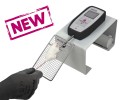Authors
J. Luszczki, P. Czuczwar, A. Cioczek-Czuczwar, M. Dudra-Jastrzebska, M. Andres-Mach et al.
Lab
Medical University of Lublin, Department of Pathophysiology, Lublin, Poland
Journal
Progress in Neuro-Psychopharmacology and Biological Psychiatry
Abstract
The aim of this study was to determine the influence of arachidonyl-2-chloroethylamide (ACEA - a highly selective cannabinoid type 1 [CB1] receptor agonist) on the protective action and acute adverse effects of carbamazepine, lamotrigine, oxcarbazepine, phenobarbital, phenytoin, and topiramate in the maximal electroshock seizure model and chimney test in mice. Tonic hind limb extension (seizure activity) was evoked in adult male albino Swiss mice by a current (sine-wave, 25 mA, 500 V, 50 Hz, 0.2s stimulus duration) delivered via auricular electrodes. Acute adverse-effect profiles of the studied antiepileptic drugs with respect to motor coordination was assessed in the chimney test. Additionally, long-term memory and skeletal muscular strength were measured along with free plasma (non-protein bound) and total brain antiepileptic drug concentrations. To inhibit the rapid metabolic degradation of ACEA by the fatty-acid amide hydrolase, phenylmethylsulfonyl fluoride (PMSF) was used at a constant ineffective dose of 30 mg/kg. Results indicate that ACEA (2.5 mg/kg, i.p.) co-administered with PMSF (30 mg/kg, i.p.), significantly enhanced the anticonvulsant activity of phenobarbital, but not that of carbamazepine, lamotrigine, oxcarbazepine, phenytoin, or topiramate in the maximal electroshock seizure test in mice. Moreover, ACEA (2.5 mg/kg) with PMSF (30 mg/kg) had no significant impact on the acute adverse effects of all examined antiepileptic drugs in the chimney test in mice. The protective index values (as quotients of the respective TD(50) and ED(50) values denoted from the chimney and maximal electroshock seizure tests, respectively) for the combinations of ACEA (2.5 mg/kg) and PMSF (30 mg/kg) with carbamazepine, oxcarbazepine, phenobarbital, and topiramate were greater than those denoted for the antiepileptic drugs administered alone. Only, the protective index values for the combination of ACEA (2.5 mg/kg) and PMSF (30 mg/kg) with lamotrigine and phenytoin were lower than those determined for the antiepileptic drugs administered alone. Pharmacokinetic experiments revealed that ACEA (2.5 mg/kg) and PMSF (30 mg/kg) affected neither free plasma (non-protein bound) nor total brain concentrations of phenobarbital in mice. Moreover, ACEA and PMSF in combination with carbamazepine, lamotrigine, oxcarbazepine, phenobarbital, phenytoin, and topiramate did not alter long-term memory or skeletal muscular strength in experimental animals. In conclusion, the enhanced anticonvulsant action of phenobarbital by ACEA and PMSF, lack of pharmacokinetic interaction and no acute adverse effects between the examined compounds, make the combination of ACEA and PMSF with phenobarbital of pivotal importance for further experimental and clinical studies. The combinations of ACEA and PMSF with carbamazepine, lamotrigine, oxcarbazepine, phenytoin, and topiramate are neutral from a preclinical viewpoint.
BIOSEB Instruments Used:
Grip strength test (BIO-GS3)

 Pain - Thermal Allodynia / Hyperalgesia
Pain - Thermal Allodynia / Hyperalgesia Pain - Spontaneous Pain - Postural Deficit
Pain - Spontaneous Pain - Postural Deficit Pain - Mechanical Allodynia / Hyperalgesia
Pain - Mechanical Allodynia / Hyperalgesia Learning/Memory - Attention - Addiction
Learning/Memory - Attention - Addiction Physiology & Respiratory Research
Physiology & Respiratory Research
 Pain
Pain Metabolism
Metabolism Motor control
Motor control Neurodegeneration
Neurodegeneration Cross-disciplinary subjects
Cross-disciplinary subjects Muscular system
Muscular system General activity
General activity Mood Disorders
Mood Disorders Other disorders
Other disorders Joints
Joints Central Nervous System (CNS)
Central Nervous System (CNS) Sensory system
Sensory system
